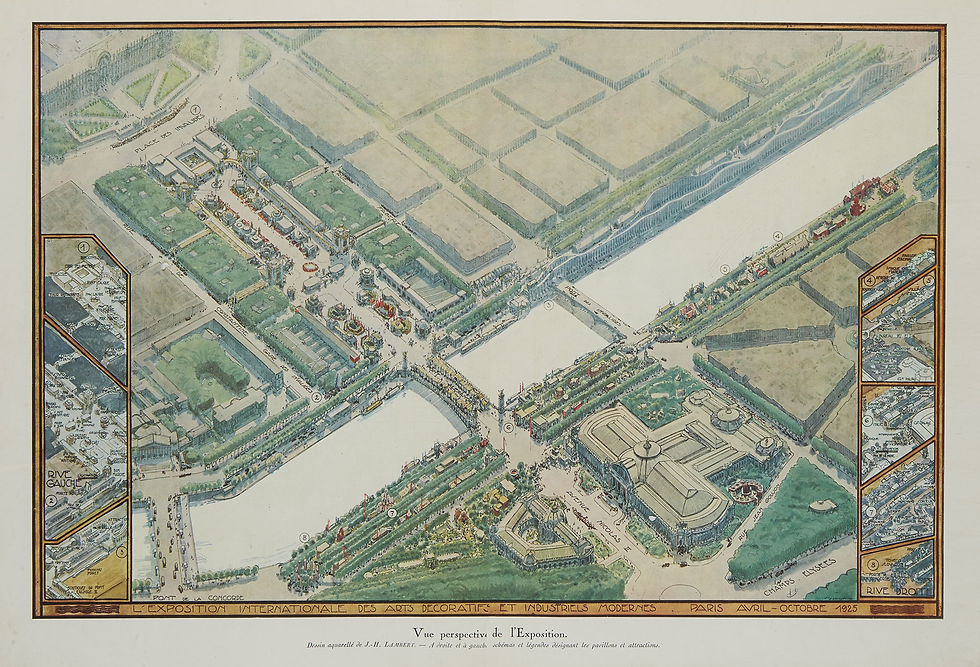The "Exposition Internationale des Arts Décoratifs et Industriels Modernes de 1925": when modernity draped itself in ornament.
- Margareth
- Sep 26
- 3 min read
From April 28 to October 25, 1925 (later extended into early November), Paris hosted the Exposition Internationale des Arts Décoratifs et Industriels Modernes—an event that would both define and give its name to the style we now call Art Déco.

In 2025, we mark the centenary of one of the most influential cultural events of the 20th century — the Exposition Internationale des Arts Décoratifs et Industriels Modernes, held in Paris in 1925. It was more than just a fair; it was the birthplace of a bold new aesthetic. From its name emerged the term Art Déco, a style that would go on to define an era of modern elegance in architecture, design, fashion, and beyond. One hundred years later, we look back on the exhibition that introduced the world to a vision of the future wrapped in geometry, glamour, and craftsmanship.
A Turning Point in Design
The 1925 exposition was not a universal fair in scale, but its ambitions were grand. Twenty‑one nations participated. It positioned itself as a showcase for modern decorative and industrial arts, pushing past the ornate excesses of Art Nouveau and rejecting revivalist styles and pastiche typical of preceding expositions.
The architecture itself became central: clean lines, stepped forms, geometric motifs. Notable architects like Robert Mallet‑Stevens, Peter Behrens, and Le Corbusier contributed to the built environment, while interior designers, furniture makers, glass artists, and decorators (e.g. Jacques‑Émile Ruhlmann, René Lalique, Jean Dunand) filled the pavilions with richly ornamented objects of modern sensibility.


What Visitors Saw & Felt
Massive pavilions built by department stores (Galeries Lafayette, Le Bon Marché, Printemps, etc.), often designed by leading architects, demonstrated how retail, art, and design could intersect.
The Hôtel d’un Collectionneur, designed by Pierre Patout for Ruhlmann, was perhaps the most celebrated setting: sumptuous interiors, elegant furniture, fine materials, and decorative arts all assembled in a single cohesive vision.
New motifs that would become hallmarks of Art Déco appeared: sun rays, stylized fountains, ziggurats, geometric abstraction, rich finishes like lacquer, bronze, exotic woods. Ornament was not abandoned but reimagined.





Legacy & Impact
The term Art Déco itself comes from the exposition’s name (“Arts Décoratifs”).
The exposition attracted about 15‑16 million visitors, confirming its popular appeal.
It elevated France—and Paris especially—as the arbiter of taste in decorative arts for the interwar period. Many of the styles and motifs seen in the expo spread around Europe and beyond in architecture, interiors, fashion, and other applied arts.
The expo also marked a shift in how decorative arts were valued: luxury craftsmanship was displayed alongside industrial processes; artistic creativity was not just for painters and sculptors but for designers, decorators, manufacturers. It helped blur the distinction between “fine” and “decorative” arts.
Why It Still Matters
A hundred years on (2025), the 1925 exposition is being reassessed in exhibitions and retrospectives as a vital moment when modern taste crystallized—not only in objects but in how people imagine comfort, luxury, good living. It showed that ornament, craftsmanship, and modern form could coexist, that design could respond to the machine age while preserving elegance. It’s no surprise then that many pieces, interiors, and motifs from that expo remain iconic.






Comments